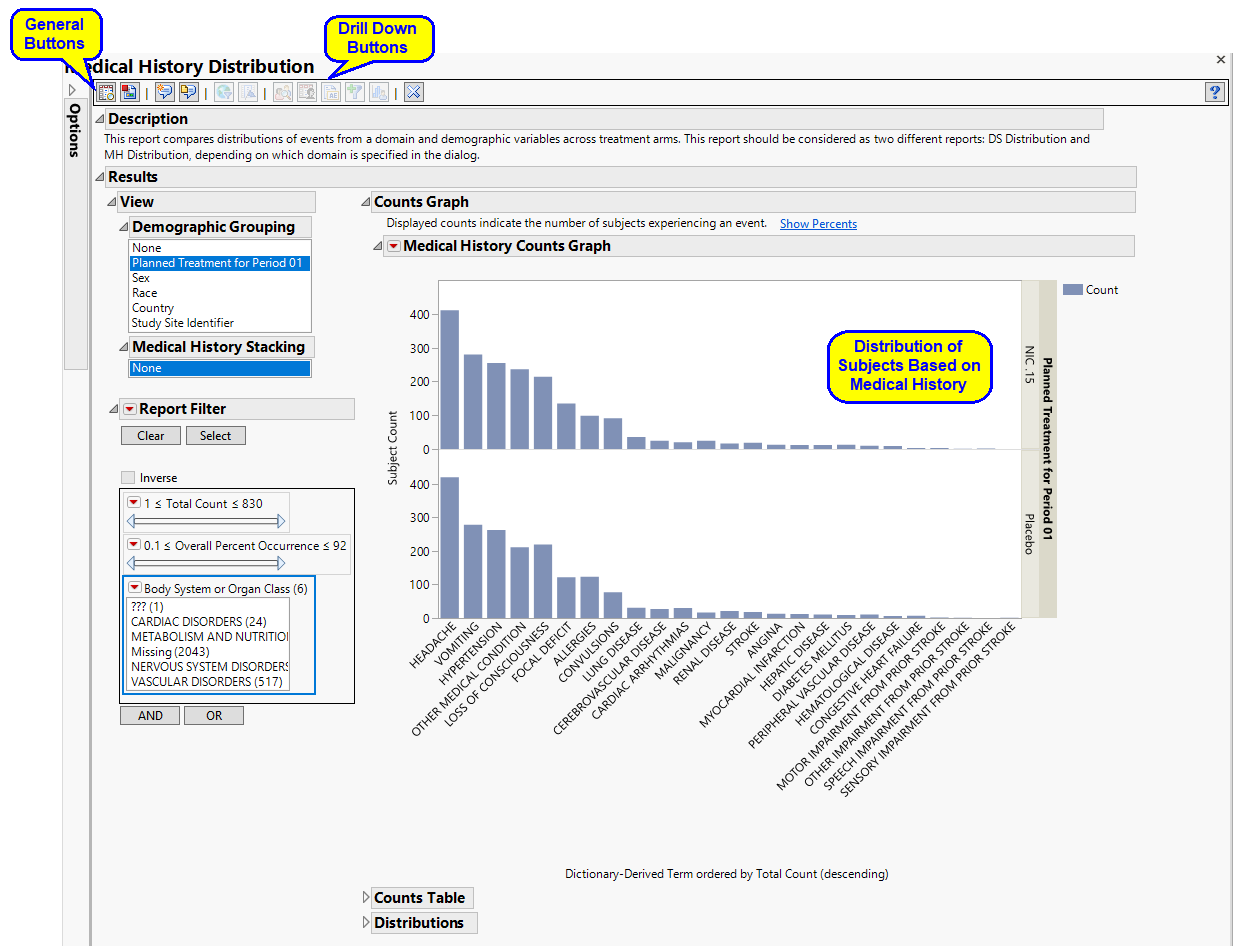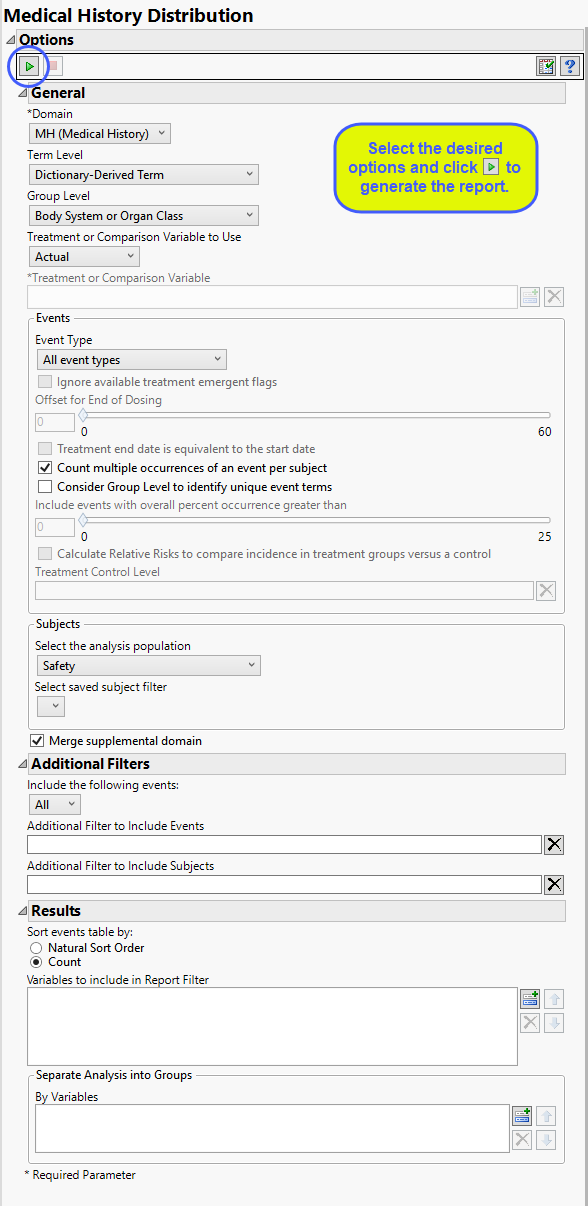Events Distribution
This report compares distributions of events from a domain and demographic variables across treatment arms.
Note: This report should be considered as two different reports: Disposition Distribution and Medical History Distribution, depending on which domain is specified in the dialog.
Note: Refer to Distribution Reports for a description of the general analysis performed by the JMP Clinical distribution reports.
Report Results Description
Running this report for Nicardipine using default settings for medical history (MH) generates the Report shown below.

Refer to the Adverse Events Distribution output description, including all of the Report elements and areas where Events Distribution differs from Adverse Events Distribution.
Note: The following notes: Multiple treatment periods have been detected and displayed. and Pre-treatment has been assigned to period=0. are inserted at the top of the report when these events are detected in your data.
Report Options

Domain
Use the Domain option to specify whether to plot the distribution of either disposition (DS) or medical history (MH) events.
Term and Group Levels
Term and Group Levels are chosen from available variables in the Event domain of interest. You must indicate how each event is named and the level at which the event is considered. For example, selecting Reported Term for the Medical History and Body System or Organ Class as the Term Level and Group Level, respectively, reports the event specified by the actual event term on the affected organ or body system as reported in the MH domain.
Treatment or Comparison Variable:
The primary goal of clinical trials is to distinguish treatment effects when reporting and analyzing trial results. Treatments are defined by specific values in the treatment or comparison variables of the CDISC models. These variables are specified in this report using the Treatment or Comparison Variable to Use andTreatment or Comparison Variable options.
Distributions of the specified treatment or comparison variables are shown in the output.
Available variables include Planned, which is selected when the treatments patients received exactly match what was planned and Actual, which is selected when treatment deviates from what was planned.
You can also specify a variable other than the ARM or TRTxxP (planned treatment) or ACTARM or TRTxxA (actual treatment) from the CDISC models as a surrogate variable to serve as a comparator. Finally you can select None to plot the data without segregating it by a treatment variable.
See Treatment or Comparison Variable to Use, Treatment or Comparison Variable for more information.
Events
By default, all events are included in the analysis. However, you can choose to consider only those that emerge at specific times before, during, or after the trial period. For example, selecting On treatment events as the Event Type includes only those events that occur on or after the first dose of study drug and at or before the last dose of drug (+ the offset for end of dosing).
If you choose to Ignore available treatment emergent flags, the analysis includes all events that occur on or after day 1 of the study.
By default, post-treatment monitoring begins after the patient receives the last treatment. However, you might want to specify an Offset for End of Dosing, increasing the time between the end of dosing and post-treatment monitoring for treatments having an extended half-life.
Check the Treatment end date is equivalent to the start date if the treatment end date (EXTENDTC) is missing from the data. In this case, it is assumed that all treatments were given on the same day and that the treatment start date can be used instead.
By default, the number of occurrences of an event is computed as the number of subjects experiencing that effect, regardless of how many times each subject experienced the effect. When a patient experiences multiple occurrences of an event, the software selects the occurrence for analysis based first on whether it is a serious event, then by severity and finally by time. When the Count multiple occurrences of an event per subject check box is checked (the default setting), the counts reported for each event represent the total of all the occurrences of that event.
Checking the Consider Group Level to identify unique event terms option uses the values of the specified Group Level to further define and distinguish unique event terms (as specified by the Term Level selection.
Use the Include events with overall percent occurrence greater than option to specify a threshold for reporting events. Only events that occur above the entered threshold (in terms of overall percent of occurrence) are displayed in the reports. This value is set to 0 by default, so that all event occurrences are included.
The Calculate Relative Risks to compare incidence in treatment groups versus a control and Treatment Control Level options are used in conjunction to compute the relative risk of experiencing each event for those subjects receiving the experimental treatment compared to the specified control group.
Filtering the Data:
Filters enable you to restrict the analysis to a specific subset of subjects and/or events, based on values within variables. You can also filter based on population flags (Safety is selected by default) within the study data.
If there is a supplemental domain (SUPPDS or SUPPMH) associated with your study, you can opt to merge the non-standard data contained therein into your data.
See Select the analysis population, Select saved subject filter1, Merge supplemental domain, Additional Filter to Include Events, and Additional Filter to Include Subjects
Results
You can opt to Sort events table by: either natural order or counts.
Use the Variables to include in Report Filter option to specify the variables to be included in the report data filter.
You can also subdivide the subjects and run analyses for distinct groups by specifying one or more By Variables.